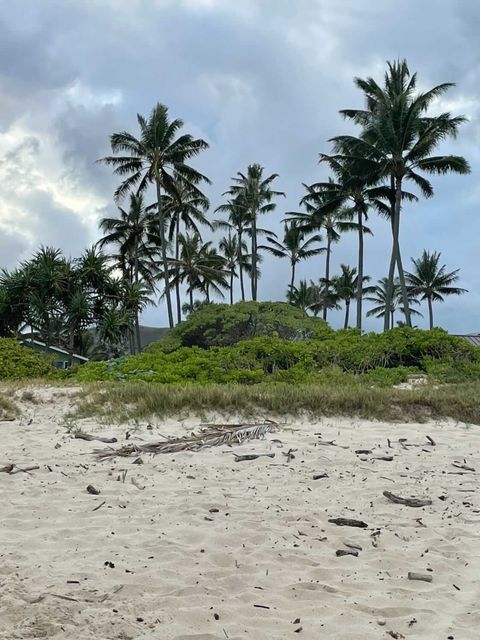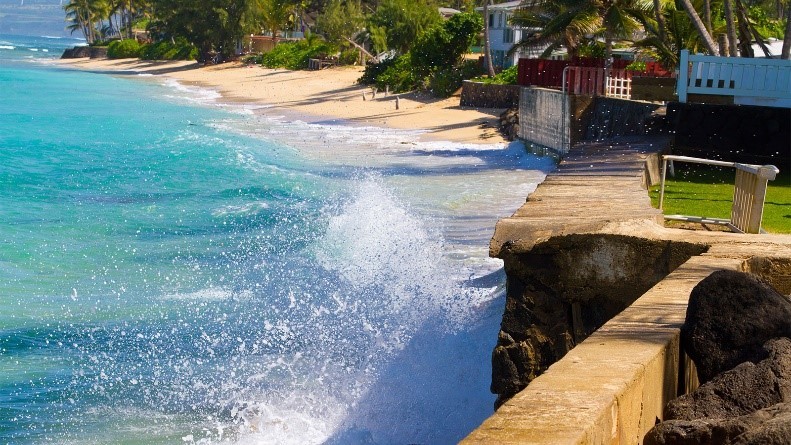- Home
- Critical Decade
- HI Climate Action
- HI Commission
- HI Resources
- HI Equity
- HI Events
What does resilience look like? Utilizing the power of nature to make Hawai‘i climate ready

 The effects of climate change in Hawaiʻi are being felt mauka to makai, from the increasing wildfires ravaging our native forests in the highlands to the eroding beaches and deteriorating infrastructure along our coastlines. Hawaiʻi and other Pacific island nations are extremely vulnerable to climate change impacts for various reasons – isolated geographic locations, extensive coastlines, limited freshwater availability, susceptibility to impacts from natural disasters, and vulnerable food systems – just to name a few. The floods and landslides that occurred on Kauaʻi, Maui, and Oʻahu in March 2021 are ominous reminders that the State must implement strategies to build a resilient future, sooner rather than later.
The effects of climate change in Hawaiʻi are being felt mauka to makai, from the increasing wildfires ravaging our native forests in the highlands to the eroding beaches and deteriorating infrastructure along our coastlines. Hawaiʻi and other Pacific island nations are extremely vulnerable to climate change impacts for various reasons – isolated geographic locations, extensive coastlines, limited freshwater availability, susceptibility to impacts from natural disasters, and vulnerable food systems – just to name a few. The floods and landslides that occurred on Kauaʻi, Maui, and Oʻahu in March 2021 are ominous reminders that the State must implement strategies to build a resilient future, sooner rather than later.
A climate emergency reignites. Although the decade started with a pandemic that brought the world to a standstill, 2021 has reignited some hope as we see governments around the globe pushing forward and taking action to tackle the climate crisis. President Biden recently announced an extensive list of climate actions the United States will take to address climate change, several countries announced their climate commitments during the Latin America and Caribbean Climate Week 2021, and this year marks the start of the United Nations Decade on Ecosystem Restoration. National climate commitments aren’t the only inspiring things happening this year – states are doing their part too. In April 2021, Hawai‘i became the first state in the U.S. to declare a climate emergency, and recently came together with six other leading Under2 Coalition state and regional governments to call for ambitious climate action and to align our financial agenda to keep global temperature rises to 1.5°C. As we continue to build momentum in the fight against the global climate crisis, there is one strategy that is gaining recognition as an effective way to build climate resilience: nature-based solutions.


“Green-blue” vs. “gray” approaches to the climate change impacts of sea level rise. The photo on the left shows a living shoreline that hides houses behind it. It is a “green-blue” nature-based solution that uses native flora like Naupaka and ‘Akiʻaki growing on sand dunes. Living shorelines help mitigate coastal erosion and also provides co-benefits such as native species habitat, sediment filtration, and protection against storm and high wave events. The picture on the right shows a seawall, an example of “gray” infrastructure that hardens the shoreline and accelerates beach loss and erodes coasts. Note the amount of beach in areas without a seawall. PC: Anu Hittle (left); joshuaraineyphotography via Getty Images (right)
An emergency needs a “two-fer” solution. Nature-based solutions (NBS) encompass the use of “green-blue” approaches, such as native forests and living shorelines, to address climate impacts. The International Union for Conservation of Nature defines nature-based solutions as “actions to protect, sustainably manage and restore natural or modified ecosystems that address societal challenges effectively and adaptively, simultaneously providing human well-being and biodiversity benefits.” NBS can absorb carbon and/or help adapt and build resilience to climate change, often all at once. Such approaches also generally produce more co-benefits than their “gray” counterparts (infrastructure that is engineered), such as artificial sea walls composed of impermeable concrete.
Solutions based in nature are best for Hawaiʻi. Hawai‘i’s forests, agriculture and ranch lands, and coastal and nearshore waters all play an important role in combating climate change and making Hawai‘i more resilient. Relative to other states, our landmass is fairly small, which means utilizing our lands and nearshore waters efficiently is vital to remaining at the forefront in the fight against the climate crisis. Nature-based solutions allow the state to use the power of its lands and nature to address resilience.
Forests can make Hawaiʻi more resilient. Though restoration and conservation of forests contribute to ecosystem resilience by increasing carbon storage, biodiversity, groundwater recharge, and more, the social benefits arising from these are often overlooked. Landscape-level programs utilizing nature-based solutions can help ecosystems that act as carbon sinks and support local communities by providing a pathway to economic recovery. The Puʻu Mali Forest Carbon Project on Mauna Kea is using a NBS approach to restore an agricultural land back into its original native forest state. This project results in an array of benefits – reef protection, wildfire mitigation, a local green economy, and the protection of cultural heritage and traditional practices – all while contributing to the State’s Carbon Neutrality goals by increasing the absorption of carbon from the atmosphere on this land.

Nature-based features along the coast can make Hawaiʻi more resilient. As the state with the 4th longest combined coastline in the nation, managing our coastal lands for resilience will play a big part in making Hawaiʻi climate ready. Implementing NBS can help reduce the impacts of coastal storms, sea level rise, and coastal erosion. Living shorelines and wetland restoration (in Hawaiʻi, this means protecting and restoring the loʻi kalo and loko iʻa) can significantly increase the State’s resilience by protecting coastal infrastructure, increasing food security, and restoring critical habitat for native species. Loko iʻa (Native Hawaiian fishponds) were once a key component in food production and food sustainability for hundreds of years, but declined dramatically after western contact and significant shifts in land-use. Today, there is an expanding movement to restore loko iʻa across the islands, with grassroots organizations like Hui Mālama Loko Iʻa, a network of Hawaiian fishpond practitioners and organizations that collaborate to educate communities about place-based stewardship and establish a knowledge exchange of traditional and contemporary fishpond practices. The Heʻeia National Estuarine Research Reserve is dedicated to practice and promote responsible stewardship and outreach consistent with the principles of the ahupuaʻa management system for the ahupuaʻa of Heʻeia, and works closely with partners like Paepae o Heʻeia, a non-profit organization dedicated to restore and care for Loko iʻa o Heʻeia (Heʻeia Fishpond).
Agricultural and ranch lands can make Hawaiʻi more resilient. Living on an isolated island archipelago, building self-sufficiency through food resilience is vital for the long-term sustainability of the state. Considering the effect a natural disaster could have on the shipments of food and other necessities to Hawai’i – where approximately 90% of the state’s food is imported from overseas – the need to build a resilient food system is clear. Although currently accounting for about 6% of our statewide greenhouse gas emissions , our agricultural lands help offset 13% of these emissions, making them an important sink to mitigate against climate change impacts. NBS in agricultural lands can provide not only benefits through various ecosystem services, but also deliver food security for people worldwide while restoring nature and climate. Well-managed rangelands, like Haleakala Ranch on Maui and Kualoa Ranch on O’ahu , can produce benefits for the surrounding ecosystem and community: watershed protection, carbon sequestration, open space preservation, wildfire mitigation, habitat preservation, noxious weed control, and protecting cultural values.

Climate readiness and nature-based solutions go hand in hand. The above examples illustrate how the efficacy of such solutions comes from the power of both nature and local communities, and in turn, the services produced also benefit both. There is no doubt that NBS will play an important role in creating a climate ready Hawai’i, but a few steps must be taken before we get there. We will need to:
- Define resilience for Hawaiʻi and establish metrics to measure progress;
- Operationalize equity to ensure the burdens brought by climate change do not fall on the shoulders of already vulnerable communities, and that the voices of all communities are heard when developing, implementing, and analyzing climate resilience plans; and
- Develop a knowledge exchange to offer the public, researchers, and other institutions a “one-stop-shop” to learn about and collaborate on climate science, traditional knowledge, and resilience efforts happening statewide.
Building resilience through NBS is further explained in the Climate Ready Hawaiʻi Working Paper on Nature-Based Resilience and Adaptation to Climate Change in Hawaiʻi .
In order to truly adapt and be resilient to the impacts of the climate crisis, many of the solutions we seek can be found if we look to the past. In Hawaiʻi and other Pacific island nations, true sustainability was a lifestyle built out of necessity. NBS build upon that place-based perspective, and emphasize that humans and nature are not separate and recognize the critical role that citizen involvement and social inclusion plays in implementing effective climate solutions, making NBS an ideal strategy for building resilience in Hawaiʻi, and an adaptable solution for the rest of the world.
This blog piece is written under the guidance of Anukriti Hittle, Coordinator for the Climate Change Mitigation and Adaptation Commission, from our Climate Ready Hawaiʻi Working Paper on Nature-Based Resilience and Adaptation to Climate Change in Hawaiʻi, which can be found here.
